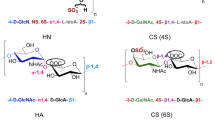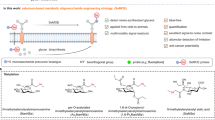Abstract
The ability to sense saccharides in aqueous media using conventional supramolecular approaches was a turning point in modern chemistry. Herein, we performed oligosaccharide sensing using fluorophore-modified branched glucans. Through the newly developed glucan-based chemosensor, acarbose sensing was achieved in a selectively and sensitive manner. The optical properties and morphological changes in the chemosensor were investigated, revealing that the globule-to-coaggregation process plays a key role in oligosaccharide sensing.
This is a preview of subscription content, access via your institution
Access options
Subscribe to this journal
Receive 12 print issues and online access
$259.00 per year
only $21.58 per issue
Buy this article
- Purchase on Springer Link
- Instant access to full article PDF
Prices may be subject to local taxes which are calculated during checkout





Similar content being viewed by others
References
James TD, Sandanayake KRAS, Shinkai S. Saccharide sensing with molecular receptors based on boronic acid. Angew Chem Int Ed Engl. 1996;35:1910–22.
Davis AP, Wareham RS. Carbohydrate recognition through noncovalent interactions: a challenge for biomimetic and supramolecular chemistry. Angew Chem Int Ed. 1999;38:2978–96.
Arnold MA, Small GW. Noninvasive glucose sensing. Anal Chem. 2005;77:5429–39.
Borisov SM, Wolfbeis OS. Optical biosensors. Chem Rev. 2008;108:423–61.
Kubik S. Synthetic lectins. Angew Chem Int Ed. 2009;48:1722–5.
Davis AP. Synthetic lectins. Org Biomol Chem. 2009;7:3629–38.
Mazik M. Molecular recognition of carbohydrates by acyclic receptors employing noncovalent interactions. Chem Soc Rev. 2009;38:935–56.
Kejík Z, Bříza T, Králová J, Martásek P, Král V. Selective recognition of a saccharide-type tumor marker with natural and synthetic ligands: a new trend in cancer diagnosis. Anal Bioanal Chem. 2010;398:1865–70.
Asensio JL, Ardá A, Cañada FJ, Jiménez-Barbero J. Carbohydrate-aromatic interactions. Acc Chem Res. 2013;46:946–54.
Wu X, Li Z, Chen XX, Fossey JS, James TD, Jiang YB. Selective sensing of saccharides using simple boronic acids and their aggregates. Chem Soc Rev. 2013;42:8032–48.
Miron CE, Petitjean A. Sugar recognition: designing artificial receptors for applications in biological diagnostics and imaging. ChemBioChem. 2015;16:365–79.
Fukuhara G. Analytical supramolecular chemistry: colorimetric and fluorimetric chemosensors. J Photochem Photobiol C Photochem Rev. 2020;42:100340.
Hu W, Zhang G, Zhou Y, Xia J, Zhang P, Xiao W, et al. Recent development of analytical methods for disease-specific protein O-GlcNAcylation. RSC Adv. 2023;13:264–80.
Cao X, Yao J, Jia M, Shen X, Zhang J, Ju S. Serum CCAT2 as a biomarker for adjuvant diagnosis and prognostic prediction of cervical cancer. J Ovar Res. 2022;15:20.
Matsunaga T, Saito H, Kuroda H, Osaki T, Takahashi S, Iwamoto A, et al. CA19-9 in combination with P-CRP as a predictive marker of immune-related adverse events in patients with recurrent or unresectable advanced gastric cancer treated with nivolumab. BMC Cancer. 2022;22:418.
Cen P, Ni X, Yang J, Graham DY, Li M. Circulating tumor cells in the diagnosis and management of pancreatic cancer. Biochimica et Biophysica Acta. 2012;1826:350–6.
James TD, Sandanayake KRAS, Shinaki S. Chiral discrimination of monosaccharides using a fluorescenct molecular sensor. Nature. 1995;374:345–7.
Yashima E, Nimura T, Matsushima T, Okamoto Y. Poly((4-dihydroxyborophenyl)acetylene) as a novel probe for chirality and structural assignments of various kinds of molecules including carbohydrates and steroids by circular dichroism. J Am Chem Soc. 1996;118:9800–1.
Samoei GK, Wang W, Escobedo JO, Xu X, Schneider HJ, Cook RL, et al. A chemomechanical polymer that functions in blood plasma with high glucose selectivity. Angew Chem Int Ed. 2006;45:5319–22.
Yang X, Lee MC, Sartain F, Pan X, Lowe CR. Designed boronate ligands for glucose-selective holographic sensors. Chem Eur J. 2006;12:8491–7.
Wang L, Li Y. Luminescent nanocrystals for nonenzymatic glucose concentration determination. Chem Eur J. 2007;13:4203–7.
Schiller A, Wessling RA, Singaram B. A fluorescent sensor array for saccharides based on boronic acid appended bipyridinium salts. Angew Chem Int Ed. 2007;46:6457–9.
Edwards NY, Sager TW, McDevitt JT, Anslyn EV. Boronic acid based peptidic receptors for pattern-based saccharide sensing in neutral aqueous media, an application in real-life samples. J Am Chem Soc. 2007;129:13575–83.
Pal A, Bérubé M, Hall DG. Design, synthesis, and screening of a library of peptidyl bis(boroxoles) as oligosaccharide receptors in water: identification of a receptor for the tumor marker TF-antigen disaccharide. Angew Chem Int Ed. 2010;49:1492–5.
Carrod AJ, Graglia F, Male L, Duff CL, Simpson P, Elsherif M, et al. Photo- and electrochemical dual-responsive iridium probe for saccharide detection. Chem Eur J. 2022;28:e202103541.
Kobayashi K, Asakawa Y, Kato Y, Aoyama Y. Complexation of hydrophobic sugars and nucleosides in water with tetrasulfonate derivatives of resorcinol cyclic tetramer having a polyhydroxy aromatic cavity: importance of guest-host CH-π interaction. J Am Chem Soc. 1992;114:10307–13.
Chinnayelka S, McShane MJ. Microcapsule biosensors using competitive binding resonance energy transfer assays based on apoenzymes. Anal Chem. 2005;77:5501–11.
Schmuck C, Schwegmann M. Recognition of anionic carbohydrates by an artificial receptor in water. Org Lett. 2005;7:3517–20.
Mazik M, Cavga H. Carboxylate-based receptors for the recognition of carbohydrates in organic and aqueous media. J Org Chem. 2006;71:2957–63.
Waki M, Abe H, Inouye M. Translation of mutarotation into induced circular dichroism signals through helix inversion of host polymers. Angew Chem Int Ed. 2007;46:3059–61.
Goto H, Furusho Y, Yashima E. Double helical oligoresorcinols specifically recognize oligosaccharides via heteroduplex formation through noncovalent interactions in water. J Am Chem Soc. 2007;129:9168–74.
Reenberg T, Nyberg N, Duus JØ, van Dongen JLJ, Meldal M. Specific recognition of disaccharides in water by an artificial bicyclic carbohydrate receptor. Eur J Org Chem. 2007;5003-9.
Ferrand Y, Crump MP, Davis AP. A synthetic lectin analog for biomimetic disaccharide recognition. Science. 2007;318:619–22.
Striegler S, Gichinga MG. Disaccharide recognition by binuclear copper(II) complexes. Chem Commun. 2008;5930-2.
Barwell NP, Crump MP, Davis AP. A synthetic lectin for β-glucosyl. Angew Chem Int Ed. 2009;48:7673–6.
Ke C, Destecroix H, Crump MP, Davis AP. A simple and accessible synthetic lectin for glucose recognition and sensing. Nat Chem. 2012;4:718–23.
Rauschenberg M, Bandaru S, Waller MP, Ravoo BJ. Peptide-based carbohydrate receptors. Chem Eur J. 2014;20:2770–82.
Mooibroek TJ, Casas-Solvas JM, Harniman RL, Renney CM, Carter TS, Crump MP, et al. A threading receptor for polysaccharides. Nat Chem. 2016;8:69–74.
Behren S, Yu J, Pett C, Schorlemer M, Heine V, Fischöder T, et al. Fucose binding motifs on mucin core glycopeptides impact bacterial lectin recognition. Angew Chem Int Ed. 2023;62:e202302437.
Fukuhara G, Inoue Y. Oligosaccharide sensing with chromophore-modified curdlan in aqueous media. Chem Commun. 2010;46:9128–30.
Ogawa K, Miyagi M, Fukumoto T, Watanabe T. Effect of 2-chloroethanol, dioxane, or water on the conformation of a gel-forming β-1,3-D-glucan in DMSO. Chem Lett. 1973;2:943–6.
Deslandes Y, Marchessault RH, Sarko A. Triple-helical structure of (1→3)-β-D-glucan. Macromolecules. 1980;13:1466–71.
Numata M, Shinkai S. ‘Supramolecular wrapping chemistry’ by helix-forming polysaccharides: a powerful strategy for generating diverse polymeric nano-architectures. Chem Commun. 2011;47:1961–75.
Eleftheriadou I, Grigoropoulou P, Katsilambros N, Tentolouris N. The effects of medications used for the management of diabetes and obesity on postprandial lipid metabolism. Curr Diabetes Rev. 2008;4:340–56.
Fukuhara G, Sasaki M, Numata M, Mori T, Inoue Y. Oligosaccharide sensing in aqueous media by porphyrin-curdlan conjugates: a prêt-á-porter rather than haute-couture approach. Chem Eur J. 2017;23:11272–8.
Sasaki M, Ryoson Y, Numata M, Fukuhara G. Oligosaccharide sensing in aqueous media using porphyrin-curdlan conjugates: an allosteric signal-amplification system. J Org Chem. 2019;84:6017–27.
Kurohara H, Hori Y, Numata M, Fukuhara G. Oligosaccharide sensing using fluorophore-probed curdlans in aqueous media. ACS Appl Polym Mater. 2023;5:2254–63.
Tamano K, Nakasha K, Iwamoto M, Numata M, Suzuki T, Uyama H, et al. Chiroptical properties of reporter-modified or reporter-complexed highly 1,6-glucose-branched β-1,3-glucan. Polym J. 2019;51:1063–71.
Mei J, Leung NLC, Kwok RTK, Lam JWY, Tang BZ. Aggregation-induced emission: together we shine, united we soar! Chem Rev. 2015;115:11718–940.
Felorzabihi N, Froimowicz P, Haley JC, Bardajee GR, Li B, Bovero E, et al. Determination of the Förster distance in polymer films by fluorescence decay for donor dyes with a nonexponential decay profile. J Phys Chem B. 2009;113:2262–72.
Sangghaleh F, Sychugov I, Yang Z, Veinot JGC, Linnros J. Near-unity internal quantum efficiency of luminescent silicon nanocrystals with ligand passivation. ACS Nano. 2015;9:7097–104.
Acknowledgements
GF acknowledges the generous support provided by Grants-in-Aid (Nos. 19H02746 and 23H04020) from the Japan Society for the Promotion of Science (JSPS). We are grateful to Prof. Yoshihisa Inoue at Osaka University for fruitful discussions.
Author information
Authors and Affiliations
Corresponding author
Ethics declarations
Conflict of interest
The authors declare no competing interests.
Additional information
Publisher’s note Springer Nature remains neutral with regard to jurisdictional claims in published maps and institutional affiliations.
Supplementary information
Rights and permissions
Springer Nature or its licensor (e.g. a society or other partner) holds exclusive rights to this article under a publishing agreement with the author(s) or other rightsholder(s); author self-archiving of the accepted manuscript version of this article is solely governed by the terms of such publishing agreement and applicable law.
About this article
Cite this article
Kurohara, H., Hori, Y., Numata, M. et al. Fluorophore-glucan conjugate for oligosaccharide sensing in aqueous media. Polym J 56, 473–480 (2024). https://doi.org/10.1038/s41428-024-00889-7
Received:
Revised:
Accepted:
Published:
Issue Date:
DOI: https://doi.org/10.1038/s41428-024-00889-7



